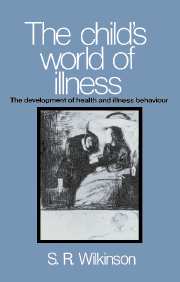Book contents
- Frontmatter
- Contents
- Acknowledgements
- Glossary
- 1 Presenting a problem
- 2 The form of dialogue
- 3 What has gone before: some background information
- 4 The primary structure to the child's world of illness
- 5 Germs and bugs: causal agents
- 6 Dirt and fresh air: the exogenous system
- 7 My castle and the good germs: the endogenous system and its boundary
- 8 ‘Pretend illness’: An analysis of how communication patterns can foster particular forms of complaints
- 9 The consultation: a form of dialogue
- 10 Health education and health promotion
- Appendixes
- References
- Index
10 - Health education and health promotion
Published online by Cambridge University Press: 23 September 2009
- Frontmatter
- Contents
- Acknowledgements
- Glossary
- 1 Presenting a problem
- 2 The form of dialogue
- 3 What has gone before: some background information
- 4 The primary structure to the child's world of illness
- 5 Germs and bugs: causal agents
- 6 Dirt and fresh air: the exogenous system
- 7 My castle and the good germs: the endogenous system and its boundary
- 8 ‘Pretend illness’: An analysis of how communication patterns can foster particular forms of complaints
- 9 The consultation: a form of dialogue
- 10 Health education and health promotion
- Appendixes
- References
- Index
Summary
‘Carrots are good for your eyes – you never see rabbits with glasses.’
(Playground joke)The research presented has not involved efforts to change the views of the children or their behaviour. To use Bronfenbrenner's (1979, p. 41) terminology there have been no ‘transforming experiments’. Such experiments would have highlighted the resistances to change and the stabilising homeostatic factors in the children's world. Nevertheless I feel that the applications of an understanding of the child's world of illness for health education and promotion must be explored. The necessary reservation is that the suggestions here need further evaluation – but they can form the bases for future research. I am not aiming to cover health education for adults, although the adult-orientated strategies in society will also influence the children.
Illness beliefs and behaviours are the natural target of health education rather than disease and sickness models, yet it has often been the latter that have attracted attention. It is through our understanding of illness that the information is meaningful to us; ‘diseases’ are less salient if they have not made a difference to our lives through being linked to the subjective elements inherent in illness concepts. Through discussing the causes of diseases some links can be made to illness models. Unless health education is presented in a relevant way and people have the competences to use it, it will not make a difference to people's ways of life.
- Type
- Chapter
- Information
- The Child's World of IllnessThe Development of Health and Illness Behaviour, pp. 237 - 266Publisher: Cambridge University PressPrint publication year: 1988

